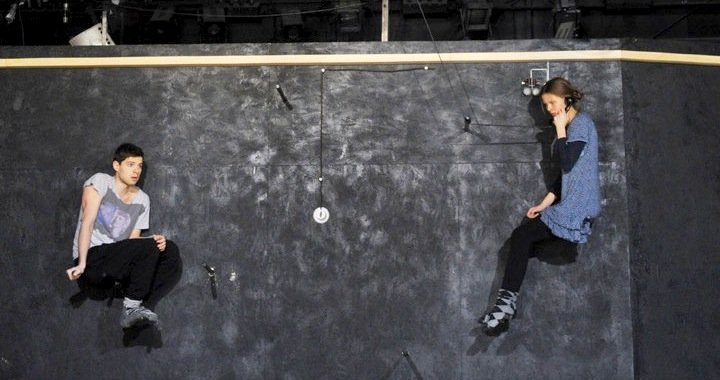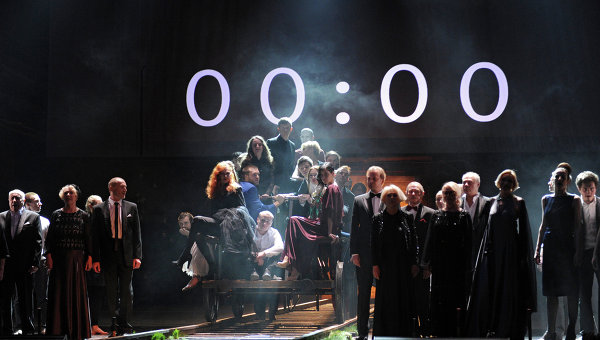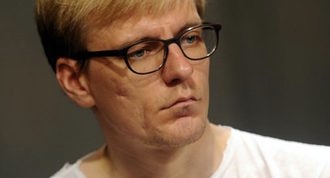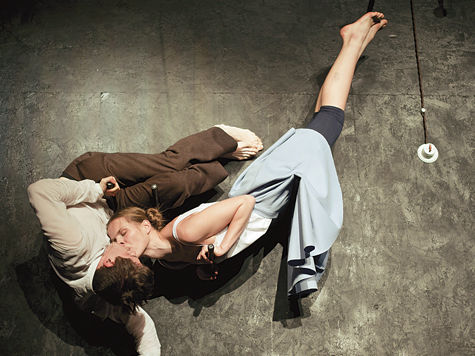
Moscow’s Gogol Theater has Become an Inter-disciplinary Cultural Center
11/03/2013
Vladislav Nastavshev (1978) was born in Riga, studied acting in St. Petersburg and directing in London, and has staged several productions in Latvia, including a version of Ivan Bunin's short novel, “Mitya's Love”. Having premiered in January 2010 at the Dirty Deal Teatro, and starring Yuri Dyakanov and Inese Pudža, the play was just shown this past February in Moscow, at the opening of the overhauled Gogol Center's Small Stage.

The opening of Gogol Center
At the very start of February, with reconstruction work still going on at full speed, a two-day art production, titled “00:00”, opened the new Gogol Center. The remodeled venue, located at Kazakov Street 8, Moscow, is now under the artistic direction of Kirill Serebrennikov. The four-part presentation that revealed the new art space was structured around time – night, morning, day and evening – and involved more than 60 artists and four new plays written specifically for the event. Moscow's new Gogol Center has come to life in the spot where, for several decades, the Gogol Theater used to stand – a struggling and barely-ever-noticed cultural institution. Even though its location couldn't get any more central by megalopolis standards, as a cultural space, it didn't have even peripheral importance on the map of Moscow.
Under the wing of Kirill Serebrennikov, the theater underwent intrinsic changes, and has now become a contemporary and inter-disciplinary space to which crowds now flock. The Spring Season at the Gogol Center will be given over to screenplays by Lars von Trier, Rainer Werner Fassbinder and Luchino Visconti, which, taking inspiration from European theater, will be remade into stage productions. Serebrennikov himself will work with von Trier's “The Idiots”, Latvian director Vladislav Nastavshev will stage Fassbinder's “Fear Eats the Soul”, and Alexei Mizgirev – “Rocco and His Brothers”.

Director Vladislav Nastavshev
Arterritory.com contacted Vladislav Nastavshev by telephone to discuss how the play, “Mitya's Love”, came to Moscow, and to find out his thoughts on Serebrennikov's vision of the theater as a place where one can not only see productions, but also buy books, eat lunch, and simply hang out. On a side-note, the Valmiera Dramatic Theater's 90th season will feature the premier of Nastavshev's production of Shakespeare's “Macbeth”, on 25 April.
How has being transferred to a different stage, and using Moscow actors, changed the production of “Mitya's Love”?
Although the production is the same in terms of form, it really did change inwardly. And I have become different as well. In Riga, “Mitya's Love” seemed like an easy and fun production. But in Moscow, the audience was crying. How does one explain that? Since 2010, I have staged several serious plays, such as “Suddenly, Last Summer”, “Miss Julie”, and “Dark Alleys”, and as a result, it appears that I, myself, have also begun to take a deeper approach now.
How did the Gogol Center come to the decision to show “Mitya's Love”?
Kirill Serebrennikov saw “Mitya's Love” in Riga, and when he became the artistic director of the Gogol Center, he remembered it and called with an offer to show it in Moscow.

From the play “Mitya's Love” in Moscow
What do you think of Kirill Serebrennikov's heading of the Gogol Center? How can his persona help the center develop?
People really didn't go to the Gogol Theater anymore; it stayed afloat with just a handful of a viewing public, and many didn't even know anything about it. So, the decision was made to revamp the theater and to change the management. Both Kirill Serebrennikov's celebrity, and the scandals that accompanied the formation of the center, have made the Gogol Center renown – and not just in Moscow.
The whole approach has changed as well, because it is no longer just a theater, but an inter-disciplinary center.
Yes, it is not just a theater – there's the program Gogol-Music, which involves musical events and concerts, and Gogol Plus, which consists of educational lectures and discussions. Before the showing of “Mitya's Love”, there was a public “meet and greet” with the well-known Russian actor Andrei Smirnov, who played the lead role in the melodrama “His Wife's Diary” (2002) – namely, he had played Ivan Bunin, the author of the novel, “Mitya's Love”. There's also a bookstore and a cafe in the Gogol Center. So that in addition to having a place to go see theater, people also have a place to simply hang out. The Schaubühne Theater in Berlin served as a model.

Kirill Serebrennikov, the head of the Gogol Center
Does this mean that being just a theater is not enough anymore ? That now you need a mix of creative industries?
No, it definitely doesn't meant that. This is simply Kirill's view, his vision. Classical format theaters can exist at the same time.
Are there any examples in Riga of a theater becoming an inter-disciplinary space? Maybe the Dirty Deal Teatro?
I'd say that the Ģertrūdes ielas Theater is more like that – it calls itself a contemporary art stage, and holds theater and dance productions, concerts and exhibitions. But it's an independent theater, without any state support, so it can't compete on the same scale as the Gogol Center.